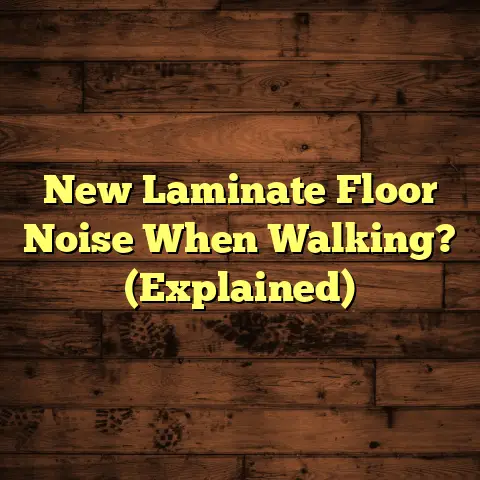The Hardest Hardwood Floors For High-traffic Areas? (Explained)
I still remember the day I was hired to install hardwood flooring in a bustling family home.
The parents were excited, and the kids were running around, full of energy.
They wanted something that could withstand their active lifestyle, and I knew right away that not all hardwood floors are created equal.
My experience taught me that some woods can handle the wear and tear of high-traffic areas much better than others.
Hardness Ratings and What They Mean
When selecting hardwood for high-traffic areas, it’s crucial to consider the Janka hardness rating.
This rating measures the wood’s resistance to wear and denting, which is especially important in homes with children and pets.
For instance, I’ve worked with oak and maple in the past.
Oak typically has a Janka rating of about 1,290 lbf (pounds-force), while maple clocks in at around 1,450 lbf.
That extra hardness can make a noticeable difference over time when you have kids running through the house or pets dashing across the floor.
The Best Hardwoods for High-Traffic Areas
1. Hickory
Hickory stands out with a Janka rating of 1,820 lbf.
I installed hickory flooring in a client’s kitchen once, and they couldn’t have been happier.
It has a beautiful grain, and the durability is unmatched.
After several years, it still looked pristine despite the daily hustle of family life.
Tip: If you choose hickory, consider a matte finish.
This not only enhances its natural beauty but also hides scratches better than glossier finishes.
2. Brazilian Cherry
Another excellent option is Brazilian cherry, boasting a Janka rating of 2,350 lbf.
I remember my first job using this wood in a high-end home.
The rich color and durability were stunning.
However, it’s worth noting that Brazilian cherry can darken over time, which surprised some homeowners.
Cost Insight: Brazilian cherry can be on the pricier side, often ranging from $5 to $12 per square foot, depending on the quality and sourcing.
Installing Brazilian cherry requires careful handling due to its density.
I’ve found that using sharp tools is essential to avoid tearing or splintering the wood during cutting.
Additionally, I always advise clients about the potential for color changes with exposure to sunlight.
3. Red Oak
Red oak is a well-known favorite among homeowners, with a rating of 1,290 lbf.
I’ve installed it in numerous homes, and it’s always been a reliable choice.
It’s versatile and can be stained to match almost any decor.
Pro Tip: If you’re working with red oak, plan for frequent maintenance in high-traffic areas.
Regular cleaning and occasional refinishing will keep it looking new.
Red oak flooring typically comes in different grades, which can affect its appearance and cost.
The common grades include:
- Select: Free of knots and blemishes; ideal for high-end installations.
- Common: May contain some knots and imperfections; offers a more rustic look.
In my experience, selecting the right grade depends on the homeowner’s style preferences and budget.
Challenges Encountered
In my years as a flooring contractor, I’ve faced challenges when working with certain hardwoods in busy households.
For example, some woods like pine are softer (with a Janka rating around 690 lbf) and didn’t hold up well under pressure.
During one project, I installed pine in a small entryway that quickly showed signs of wear.
The homeowners were disappointed; however, this experience taught me to always discuss the suitability of different woods for specific areas with clients.
Another challenge arose when working with exotic woods like teak or mahogany.
While they are stunning choices for aesthetics, their higher costs and specific installation requirements can be daunting for some homeowners.
Installation Tips
Installing hardwood flooring requires precision and attention to detail.
- Acclimation: Always acclimate your hardwood planks before installation for at least 48 hours.
This helps minimize expansion and contraction after installation. - Subfloor Preparation: Ensure your subfloor is clean, dry, and level.
A poorly prepared subfloor can lead to creaking or uneven surfaces over time. - Expansion Gaps: Leave adequate expansion gaps around the edges during installation to allow for movement due to temperature changes.
- Nailing Patterns: When nailing down hardwood planks, I often use a diagonal nailing pattern in high-traffic areas for added stability.
This technique can help prevent squeaks and movement over time. - Finishing Touches: After installation, I recommend applying a protective finish suitable for high-traffic areas.
A polyurethane finish can provide an extra layer of protection against scratches and wear.
Maintenance Matters
Taking care of hardwood floors in high-traffic areas is crucial for longevity.
- Regular Cleaning: Use a soft broom or a vacuum without a beater bar to remove dirt and debris.
- Avoid Water: Excessive water can warp wood floors; use damp mops instead of soaking them.
- Refinishing: Depending on traffic levels, consider refinishing every 3–5 years to maintain that fresh look.
- Furniture Pads: I advise clients to place pads under furniture legs to prevent scratching when moving pieces around.
Cost Estimation with FloorTally
When estimating costs for my projects, I often rely on FloorTally for its accuracy and efficiency.
It pulls local material and labor rates, allowing me to create realistic budgets for my clients effortlessly.
For instance, during a project where I used hickory flooring, FloorTally helped me calculate not just the cost of the wood but also the installation factors.
The estimates included everything from underlayment to finishing materials, which means no hidden surprises for my clients.
The comprehensive breakdown provided by FloorTally also makes it easy for me to explain costs to clients clearly.
They appreciate knowing where their money is going, especially when they are investing in durable hardwood flooring.
Comparing Different Hardwoods
When deciding on hardwoods for high-traffic areas, consider their pros and cons:
Personal Anecdotes: Successes and Challenges
One particular project stands out in my memory—a large open-concept space where the owners wanted a seamless transition from their kitchen to the living room using hickory flooring.
The challenge was figuring out how to handle the moisture levels since it was near an exterior door leading to their backyard.
I decided to install an extra moisture barrier underneath the planks while ensuring proper ventilation in the area.
The result?
A stunning floor that has held up beautifully against all the foot traffic since its installation three years ago.
However, not every project goes smoothly.
In another home, I installed maple flooring only to find that it didn’t hold up well against their pets’ claws.
The owners were frustrated when scratches started appearing within months of installation.
This experience taught me the importance of matching flooring types not just with lifestyle but also with specific activities in the home.
The Role of Finish in Durability
The finish you choose can significantly impact your hardwood floor’s resilience against wear and tear.
- Oil-Based Polyurethane: This finish provides excellent durability but can take longer to dry and has a strong odor during application.
- Water-Based Polyurethane: This option dries faster and has less odor but may require more frequent reapplication compared to oil-based finishes.
- Aluminum Oxide Finish: Often used on pre-finished hardwood floors, this finish offers superior scratch resistance and longevity but is generally more expensive.
In my experience, I’ve found that clients often overlook how finishes can affect maintenance schedules.
A more durable finish may mean less frequent refinishing but at a higher upfront cost.
Conclusion: Making Informed Choices
Choosing the right hardwood for high-traffic areas can make all the difference in maintaining the beauty and functionality of your flooring.
From hickory’s durability to Brazilian cherry’s elegance, each wood brings unique characteristics.
Reflecting on my experiences, I find that engaging in open conversations with clients about their lifestyles helps guide them toward the best choices.
The right hardwood can withstand daily wear while enhancing the home’s aesthetic appeal—it’s all about finding balance.
If you’re faced with deciding on flooring options for your space, think about how you use your home daily and what will stand up to your family’s activities.
Happy flooring!





